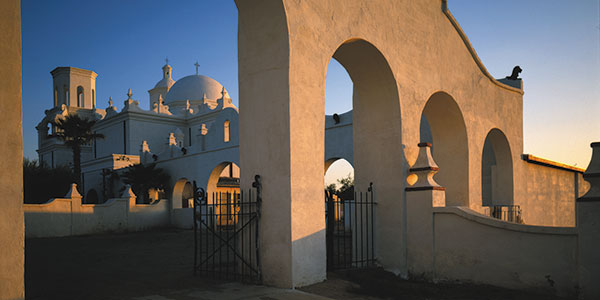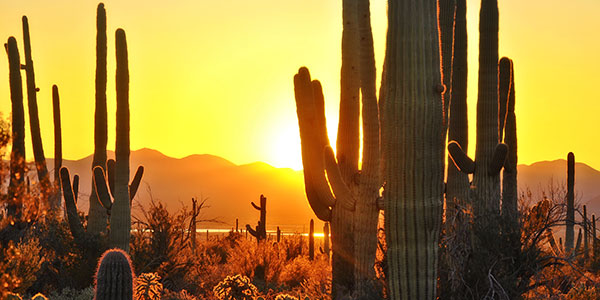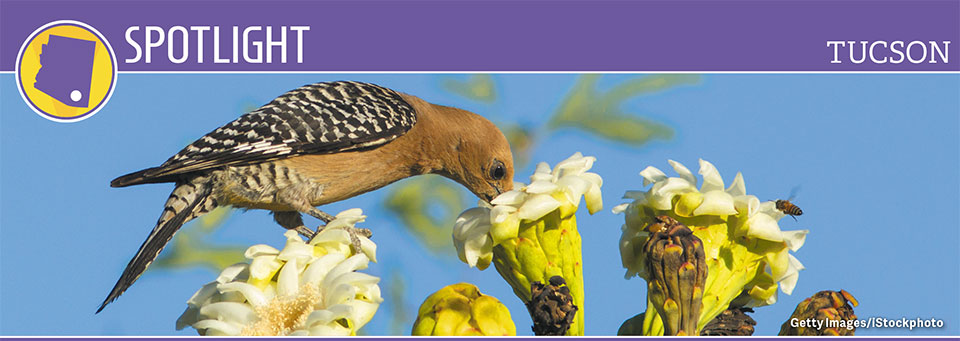Tucson
Tucson celebrates its Hispanic roots and rugged charm
While Phoenix embraces modernity with its urban dash and sprawl, Tucson clings proudly to its Hispanic heritage, ever happy to play the attractive, effervescent and culturally rich Southwestern sibling. Arizona’s second-largest city, Tucson fuses Native American, Spanish, Mexican and Anglo traditions with aplomb.
The town’s rich Latino heritage (more than 40 percent of the population is Hispanic) finds expression within the charming kernel of restored adobe homes, museums, galleries, plant-filled courtyards and historic landmarks that form the Presidio Historic District, named for the Spanish-built fortress Presidio de San Agustín del Tucson.
According to historical lore, the Presidio neighborhood is one of the oldest inhabited places in the nation, dating to 1775. Innovative Mexican restaurants seduce gourmet diners, and a reconstructed tranche of the town’s original Spanish fort stands evocatively at the corner of North Church Avenue and Washington Street. The original fort itself was built over a Hohokam site, dated A.D. 700-900.
For shopping with a regional slant, Old Town Artisans forms a unique labyrinth of adobe structures brimming with art galleries, crafts shops and eclectic boutiques. The Tucson Museum of Art’s modern building is surrounded by a historic block comprising five houses, constructed between the mid-1850s and 1907. These house a permanent collection of modern and contemporary art from Latin America and the American Southwest as well as rare books and manuscripts.
The Turquoise Trail (formerly the Presidio Trail) is a highly informative 2½-mile, self-guided walking tour, which takes in 23 historic sites. A map is available online.

©Randy Prentice
Exploring Saguaro National Park
At nearby Saguaro National Park, 13 miles east of the city center, myriad hiking trails lead through the Sonoran Desert. This is the only place where saguaro cacti— those enormous, treelike cacti that epitomize the American Southwest—grow naturally. Threatened by rampant development and susceptible to the ravages of fire and frost, these slowly maturing cacti grow profusely around Tucson. These amazing plants have been known to grow as high as 45 feet.
In 1933, Saguaro National Monument was designated by the federal government to protect these gargantuan, flowering plants; the monument was elevated to national park status in 1994. Separated into two distinct units, the Tucson Mountain District to the west of Tucson and the Rincon Mountain District to the east, Saguaro National Park protects close-knit stands of saguaros, in addition to flora and fauna that is unique to the Sonoran Desert.
Separated by 30 miles, both sections can be accessed by vehicle and are crisscrossed with hiking trails and nature trails dotted with picnic grounds. The park’s western unit draws most visitors because of its arresting stands of noble saguaros and the unit’s proximity to the Arizona-Sonora Desert Museum and Old Tucson Studios, which celebrates the golden age of Western movies with attractions and movie sets.

©Randy Prentice
Bird-Watching Bonanza
Ornithologists have a soft spot for Arizona, and the Tucson area is no exception. At the man-made Sweetwater Wetlands (created as part of a wastewater treatment facility), an extensive network of trails meander alongside ponds and canals decked out with viewing platforms. This diverse wildlife habitat attracts a wide variety of bird species. The warm springs at Roy P. Drachman Agua Caliente Regional Park, to the northeast of Tucson, also provide a haven for dozens of species, including vermilion flycatchers, waterfowl and soras.
In the immediate Tucson area, about 40 miles south of the city, Madera Canyon, with its year-round water, attracts an impressive assortment of bird life. Avid birders the nation over flock to the canyon, which is part of Coronado National Forest. Armed with binoculars and birding guides, they come in the hope of checking off more than a dozen species of hummingbirds and flycatchers, in addition to rare birds unique to Arizona, such as buntings, warblers, tanagers and grosbeaks.
Myriad Minerals
The ASARCO Mineral Discovery Center is the only modern working copper mine in all of southern Arizona to offer regularly scheduled public tours without a prior reservation. The one-hour bus tour to the rim of the ASARCO Mission open-pit mine and deep into the nerve center of the grinding mill building is educational and entertaining in equal measure. The Mineral Discovery Center comprises two hexagonal pods crowned by copper roofs.
The north pod’s well-conceived permanent exhibits reveal how the earth’s natural processes form copper deposits before going on to explicate the methods and processes utilized by miners to extract the copper minerals from the rock to produce 99.99 percent pure copper metal. The center’s family-friendly credentials are boosted with the “cutaway kitchen,” which presents some of the commonplace uses of copper in the home.
For More Information
Tucson Visitor Center
800-638-8350
www.visittucson.org
Arizona Office of Tourism
866-275-5816
www.arizonaguide.com







